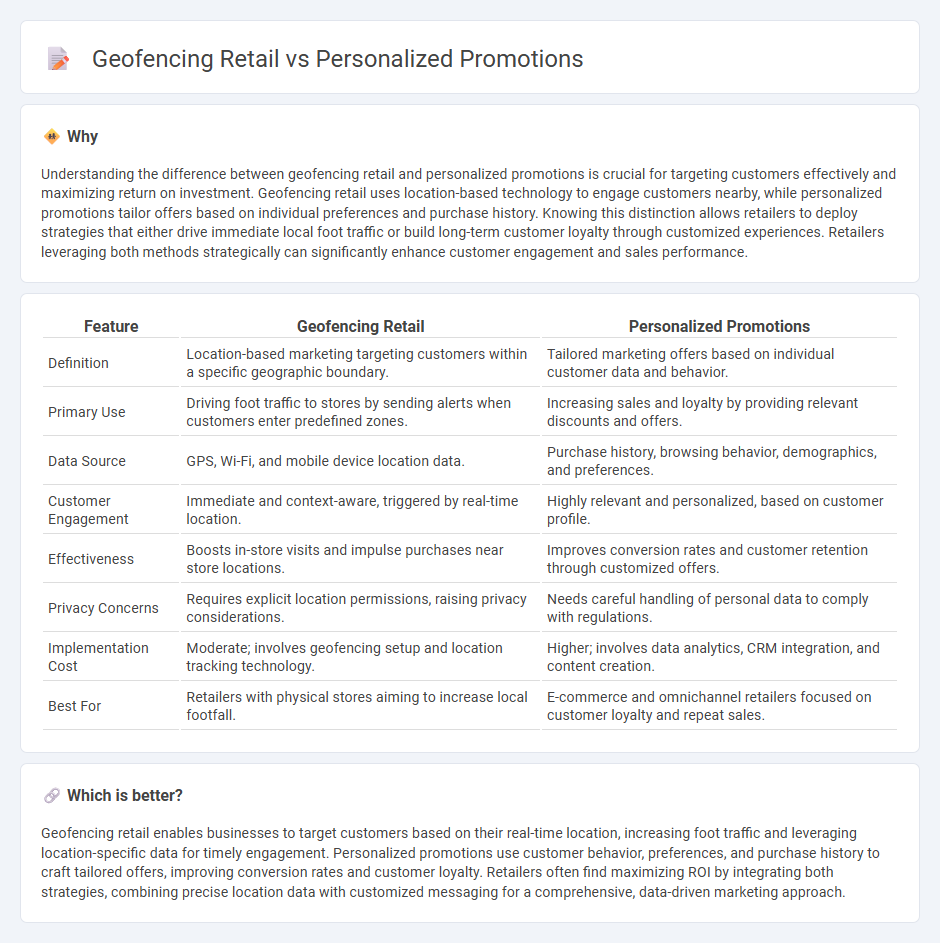
Geofencing retail leverages location-based technology to target customers within a specific geographic area, enhancing foot traffic and local engagement. Personalized promotions use data analytics to tailor offers based on individual preferences and shopping behaviors, boosting conversion rates and customer loyalty. Explore how combining these strategies can maximize retail marketing effectiveness.
Why it is important
Understanding the difference between geofencing retail and personalized promotions is crucial for targeting customers effectively and maximizing return on investment. Geofencing retail uses location-based technology to engage customers nearby, while personalized promotions tailor offers based on individual preferences and purchase history. Knowing this distinction allows retailers to deploy strategies that either drive immediate local foot traffic or build long-term customer loyalty through customized experiences. Retailers leveraging both methods strategically can significantly enhance customer engagement and sales performance.
Comparison Table
| Feature | Geofencing Retail | Personalized Promotions |
|---|---|---|
| Definition | Location-based marketing targeting customers within a specific geographic boundary. | Tailored marketing offers based on individual customer data and behavior. |
| Primary Use | Driving foot traffic to stores by sending alerts when customers enter predefined zones. | Increasing sales and loyalty by providing relevant discounts and offers. |
| Data Source | GPS, Wi-Fi, and mobile device location data. | Purchase history, browsing behavior, demographics, and preferences. |
| Customer Engagement | Immediate and context-aware, triggered by real-time location. | Highly relevant and personalized, based on customer profile. |
| Effectiveness | Boosts in-store visits and impulse purchases near store locations. | Improves conversion rates and customer retention through customized offers. |
| Privacy Concerns | Requires explicit location permissions, raising privacy considerations. | Needs careful handling of personal data to comply with regulations. |
| Implementation Cost | Moderate; involves geofencing setup and location tracking technology. | Higher; involves data analytics, CRM integration, and content creation. |
| Best For | Retailers with physical stores aiming to increase local footfall. | E-commerce and omnichannel retailers focused on customer loyalty and repeat sales. |
Which is better?
Geofencing retail enables businesses to target customers based on their real-time location, increasing foot traffic and leveraging location-specific data for timely engagement. Personalized promotions use customer behavior, preferences, and purchase history to craft tailored offers, improving conversion rates and customer loyalty. Retailers often find maximizing ROI by integrating both strategies, combining precise location data with customized messaging for a comprehensive, data-driven marketing approach.
Connection
Geofencing in retail enables precise location-based targeting by creating virtual boundaries around physical stores, triggering personalized promotions when customers enter these zones. This technology allows retailers to deliver tailored offers and discounts in real-time, enhancing customer engagement and boosting sales conversion rates. Integrating customer data with geofencing enhances the effectiveness of personalized marketing strategies by aligning promotions with shoppers' behaviors and preferences.
Key Terms
Customer Segmentation
Personalized promotions leverage advanced customer segmentation by analyzing purchase history, preferences, and behavior to deliver tailored offers that enhance engagement and conversion rates. Geofencing retail employs location-based technology to trigger contextually relevant promotions when customers enter specific geographic boundaries, optimizing timely interactions and local relevance. Explore how combining these strategies can revolutionize your retail marketing effectiveness and customer experience.
Location-Based Targeting
Personalized promotions leverage detailed customer data such as purchase history and preferences to deliver tailored offers that increase engagement and sales. Geofencing retail uses GPS or RFID technology to create virtual boundaries, triggering location-specific promotions when customers enter designated areas, enhancing relevance and immediacy. Explore how integrating personalized promotions with geofencing can optimize your location-based targeting strategy for maximum impact.
Real-Time Engagement
Personalized promotions leverage customer data to deliver tailored offers at the optimal moment, increasing conversion rates by addressing individual preferences and purchase history. Geofencing retail uses GPS technology to trigger location-based alerts, enabling real-time engagement with shoppers as they enter or move within a defined perimeter. Explore how combining these strategies can enhance customer interactions and drive sales through precise, context-aware marketing.
Source and External Links
The Definitive Guide to Personalised Promotions - Businesses use CRM and AI to tailor promotions to individual behaviors, special occasions, and preferred channels, creating unique incentives like anniversary codes, birthday discounts, and geo-targeted holiday deals.
Personalized Promotional Gifts - Customizing promotional products with names, messages, or specific details builds brand recognition and loyalty by making customers feel individually valued through exclusive, tailored items.
Personalization and promotion marketing - Individually tailored bundle promotions, personalized referral rewards, and targeted email campaigns help attract, convert, and retain customers by offering relevant incentives based on their activity and preferences.
 dowidth.com
dowidth.com